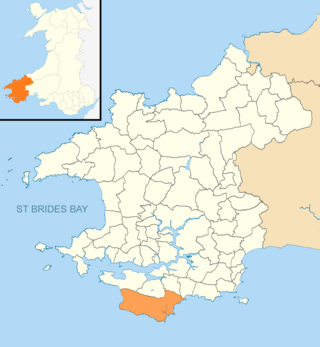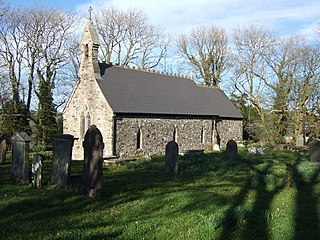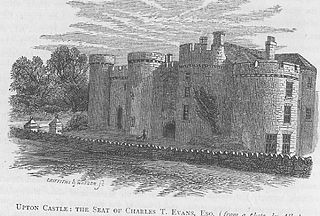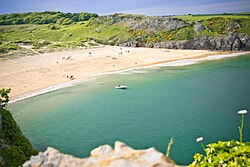
Earl Cawdor, of Castlemartin in the County of Pembroke, is a title in the Peerage of the United Kingdom. It was created in 1827 for the politician John Campbell, 2nd Baron Cawdor.

Pembrokeshire Coast National Park is a national park along the Pembrokeshire coast in west Wales.

Frederick Archibald Vaughan Campbell, 3rd Earl Cawdor,, styled Viscount Emlyn from 1860 to 1898, was a British Conservative politician. He served briefly as First Lord of the Admiralty between March and December 1905.

John Frederick Campbell, 1st Earl Cawdor was a British peer and MP.

John Campbell, 1st Baron Cawdor, FRS, FSA was a British politician, military officer and peer who sat in the House of Commons of Great Britain from 1777 to 1796.

Barafundle Bay is a remote, slightly curved, east-facing sandy beach, near Stackpole Quay in Pembrokeshire, Wales, in Stackpole and Castlemartin Community. It is part of the Stackpole Estate, managed by The National Trust. The beach was once owned by the Cawdor family of Stackpole Court. On the northern approach to the beach are steps and a wall, which were built by the owners to ease their access to what was then their private beach.

Bosherston is a village and parish in Pembrokeshire, Wales, within the Pembrokeshire Coast National Park.

Broad Haven is a village and seaside resort in the south east corner of St Bride's Bay at the western terminus of the B4341 road in south Pembrokeshire, Wales.

Llanstadwell is a small village, parish and community in south Pembrokeshire, Wales.
Castlemartin is a village and parish in the community of Stackpole and Castlemartin, Pembrokeshire, Wales, in the Pembrokeshire Coast National Park.

Lawrenny is a village and parish in the community and electoral ward of Martletwy in the county of Pembrokeshire, Wales. It is on a peninsula of the River Cleddau estuary upriver from Milford Haven where it branches off towards the Cresswell and Carew Rivers and is in the Pembrokeshire Coast National Park.

Warren is an ancient parish in the community of Stackpole and Castlemartin, in the most southerly part of Pembrokeshire, Wales. Its northern edge is 5 miles (8 km) south of Pembroke and its southern edge reaches the sea at Flimston Bay. It is bordered by Castlemartin to the west, St Twynnells to the east and Monkton to the north.
Slebech was a community in Pembrokeshire, Wales, which is now part of the combined community of Uzmaston and Boulston and Slebech, a sparsely populated community on the northern shore of the Eastern River Cleddau. The community shares boundaries with the communities of Wiston and Llawhaden and mainly consists of farmland and woodland. Much of the community is within the Pembrokeshire Coast National Park and Picton Castle's stable block loft is an important breeding roost for the rare Greater Horseshoe Bat.
John Campbell of Stackpole Court and Cawdor (1695–1777), was a British politician. He was a Member of Parliament (MP) for Pembrokeshire, Nairnshire, Inverness Burghs and Corfe Castle.

Castlemartin Training Area is a British Army military training area and armoured fighting vehicle range located in the Welsh county of Pembrokeshire. It was originally established for tank training by the Royal Armoured Corps in 1938. The training area is located within the Pembrokeshire Coast National Park, on the South Pembrokeshire coast.

Golden Grove is a mansion and estate in the Welsh county of Carmarthenshire, located 4 miles (6 km) southwest of Llandeilo.

Stackpole and Castlemartin is a community in Pembrokeshire, Wales, 4 miles (6.4 km) south of Pembroke.

Granston is a hamlet and parish in Pembrokeshire, Wales. The parish was in the Hundred of Dewisland and includes the settlements of Llangloffan and Tregwynt, with Tregwynt woollen mill. Granston is in the community of Pencaer.

Upton, Pembrokeshire is a small, rural parish in Pembrokeshire, Wales, in which Upton Castle and Upton Chapel are significant buildings dating back to Norman times.

St Elidyr's Church, is a Grade I listed building in south Pembrokeshire, Wales. The church is in the small village of Carew Cheriton in the southwest of the parish of Stackpole Elidor, on the Stackpole Estate in the community of Stackpole and Castlemartin.






















